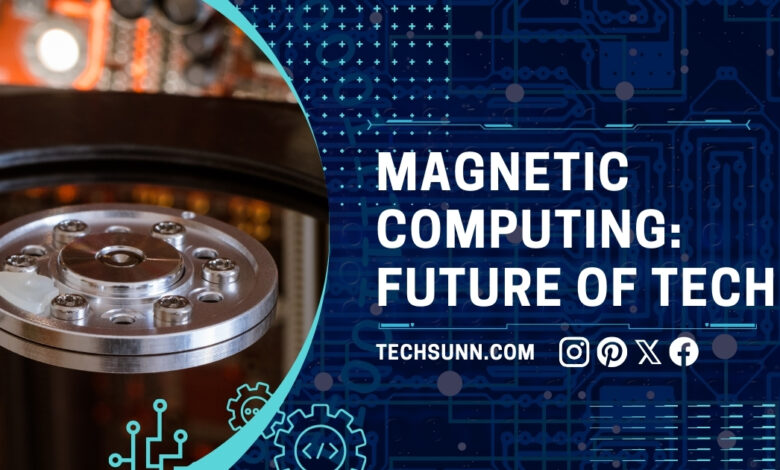Magnetic Computing: Future of Tech

Open the capability of magnetic computing: productive data stockpiling, AI applications, and future tech patterns.
Prologue to Magnetic Computing
Magnetic computing addresses a progressive way to deal with data handling and stockpiling, using the magnetic properties of materials rather than conventional electrical flows. This creative technology offers the potential for critical progressions in energy efficiency, data thickness, and handling speed, molding the eventual fate of computing. From its origin to its present status of improvement, magnetic computing has caught the consideration of specialists and pioneers around the world, promising forward leaps that could rethink the constraints of innovative possibility.
What is Magnetic Computing?
Magnetic computing is a state of the art technology that separates from customary electronic computing by utilizing the magnetic properties of materials for data handling and stockpiling. Not at all like regular strategies that depend on electrical flows, magnetic computing tackles the characteristic attraction of materials to control data. This original methodology offers a few benefits, including improved energy efficiency, non-unpredictability, and possibly higher handling speeds. Basically, magnetic computing addresses a central change in the manner we imagine and construct computing gadgets, opening up additional opportunities for additional effective and strong frameworks.
History of Magnetic Computing
The historical backdrop of magnetic computing traces all the way back to the mid-twentieth hundred years, set apart by the improvement of magnetic center memory during the 1950s. This achievement prompted further examination into magnetic materials, coming full circle in forward leaps like magnetoresistive impacts and spintronics. These progressions prepared for technologies like MRAM and MTJs, changing data stockpiling and handling. Today, progressing innovative work keep on impelling magnetic computing forward, promising considerably more prominent headways and advancements later on.
How Magnetic Computing Functions
Magnetic computing capabilities by using the magnetic properties of materials to deal with data and store data. This includes systems like Magnetoresistive Random Access Memory (MRAM) and spintronics, where data is encoded and controlled through the direction of magnetic domains or electron turn. By taking advantage of these properties, magnetic computing offers quicker data access, non-unpredictable capacity, and the potential for more effective computing structures contrasted with conventional electronic strategies.
Magnetoresistive Random Access Memory
Magnetoresistive Random Access Memory is a foundation of magnetic computing, upsetting data stockpiling by encoding data through the magnetic direction of cells. Dissimilar to customary Slam, MRAM’s magnetic domains address binary data, considering quick read and compose activities with negligible power utilization. Its non-unstable nature guarantees data maintenance even without power, making it reasonable for applications requiring moment on usefulness. With its speed, efficiency, and flexibility, MRAM is ready to change different areas, from purchaser hardware to data focuses, driving the development of computing models.
Spintronics
Spintronics, a pivotal part of magnetic computing, tackles the characteristic twist of electrons to encode and deal with data, veering from customary hardware exclusively dependent on electron charge. By controlling electron turns, spintronic gadgets empower proficient rationale activities and non-unpredictable data stockpiling, offering benefits, for example, lower power utilization and quicker speeds. Parts like twist valves, containing magnetic layers isolated by non-magnetic spacers, work with turn based electronic gadgets, promising applications in magnetic sensors, memory, and rationale entryways as exploration advances, molding the scene of future computing technologies.
Benefits of Magnetic Computing
Magnetic computing offers a large group of benefits over conventional electronic computing, including upgraded energy efficiency because of its usage of magnetic properties instead of electrical flows, non-unstable capacity capabilities guaranteeing data maintenance even without power, and potential for quicker access times and higher data thickness. These elements make magnetic computing especially appropriate for applications requiring energy efficiency, moment on usefulness, and reduced stockpiling arrangements, situating it as a groundbreaking technology ready to change different businesses.
Uses of Magnetic Computing
Magnetic computing holds different applications across different areas, including data stockpiling arrangements where technologies like Magnetoresistive Random Access Memory (MRAM) offer non-unpredictable capacity with quick access times, taking care of necessities in shopper hardware, car frameworks, and data focuses. Moreover, in the domain of artificial intelligence (AI), magnetic computing’s energy efficiency and computational power are gainful for improving AI applications, for example, AI calculations and brain organizations, cultivating headways in regular language handling, picture acknowledgment, and independent frameworks. Besides, magnetic computing exhibits potential in fields like magnetic sensors and quantum computing, with spintronic-based sensors offering high awareness and reliability for applications in clinical gadgets, modern hardware, and natural observing, while the cooperative energy between magnetic computing and quantum computing holds guarantee for leap forwards in quantum data handling.
Data Stockpiling
One of the essential uses of magnetic computing is in data capacity, where imaginative technologies, for example, Magnetoresistive Random Access Memory assume a urgent part. MRAM offers non-unstable capacity capabilities with quick access times, making it reasonable for many applications across enterprises. From purchaser gadgets to data focuses, MRAM gives solid and effective data stockpiling arrangements. Its ability to retain data even without power guarantees moment on usefulness and data industriousness, while its quick perused and compose speeds work with fast recovery and handling of data. With its conservative size and energy-proficient activity, MRAM is ready to reform how data is put away and accessed in different mechanical applications.
Artificial Intelligence
Artificial intelligence (AI) stands to benefit generally from the degrees of progress in magnetic computing. Magnetic computing’s energy efficiency and computational power make it appropriate for AI applications, including AI calculations and brain organizations. By utilizing magnetic computing, AI frameworks can perform complex calculations all the more productively, prompting headways in regions, for example, regular language handling, picture acknowledgment, and independent frameworks. The combination of magnetic computing and AI can possibly drive advancement across businesses, molding the eventual fate of technology and extending the capabilities of clever frameworks.
Difficulties and Limits
In spite of its promising benefits, magnetic computing faces difficulties and restrictions that upset its far and wide reception and further turn of events. Key difficulties incorporate scalability, as guaranteeing the powerful scaling of magnetic computing frameworks while maintaining execution is critical. Producing intricacy represents another obstacle, with unpredictable cycles requiring refinement for cost-viability and quality control. Compatibility with existing framework and norms, as well as uncertainties in innovative work, likewise present deterrents. Addressing these difficulties will be fundamental to completely saddle the capability of magnetic computing and drive it towards inescapable commercialization and incorporation into different mechanical applications.
Conclusion
In conclusion, magnetic computing addresses a change in perspective in the field of computing, offering various benefits and energizing possibilities for what’s in store. With developments like Magnetoresistive Random Access Memory (MRAM) and spintronics, magnetic computing gives energy-proficient, non-unpredictable, and high velocity data capacity and handling arrangements. From data capacity to artificial intelligence, magnetic computing is ready to reform different ventures and reshape the innovative scene. Nonetheless, difficulties like scalability, fabricating intricacy, and compatibility with existing framework should be addressed to open the maximum capacity of magnetic computing. In spite of these difficulties, proceeded with innovative work endeavors hold the commitment of conquering hindrances and driving magnetic computing towards far and wide reception and reconciliation into different applications. As we venture forward, magnetic computing remains as a guide of development, preparing for a more proficient, strong, and sustainable future in computing technology.
FAQs
1. Is magnetic computing equivalent to quantum computing?
No, magnetic computing and quantum computing are particular technologies, in spite of the fact that they might complete one another in certain applications.
2. What are the essential difficulties impeding the boundless reception of magnetic computing?
Scalability and assembling intricacy are among the main difficulties confronting magnetic computing technology.
3. Might magnetic computing at any point totally supplant customary electronic computing?
While magnetic computing offers a few benefits, it is probably not going to supplant customary electronic computing frameworks sooner rather than later totally.
4. Are there any true utilizations of magnetic computing presently being used?
Indeed, magnetic computing is now being utilized in certain data stockpiling arrangements and has likely applications in regions like artificial intelligence.




